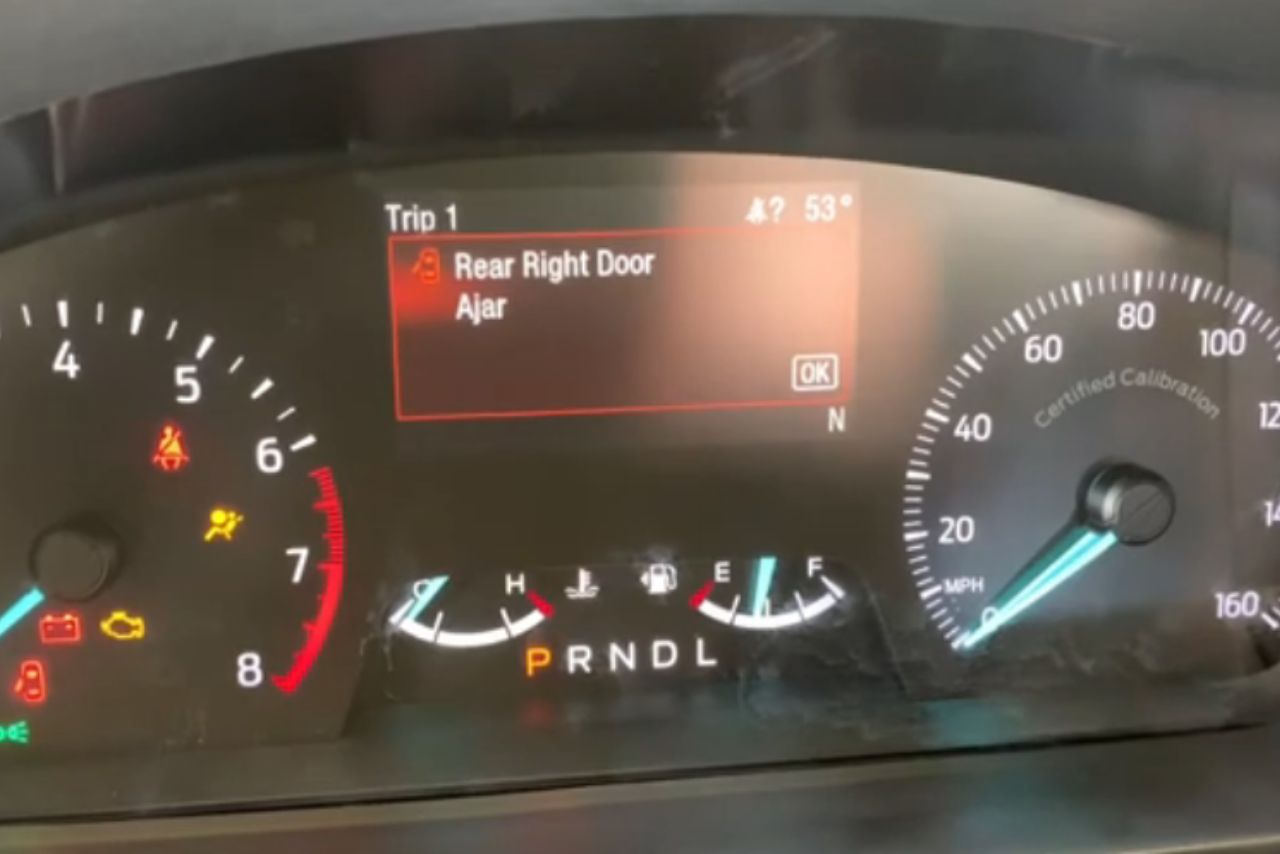Having trouble with the rear belt monitor on your Ford vehicle? You’re not alone. Many Ford owners have experienced a ‘Rear Belt Monitor Fault on Ford,’ leaving them stumped and searching for solutions.
This issue can stem from various causes, including sensor malfunctions or wiring issues.
In this article, we’ll delve into the common reasons behind the troubling ‘Rear Belt Monitor Fault’ and provide simple fixes to get your Ford back in top shape.
Whether it’s a faulty sensor or compromised wiring, we’ve got you covered with practical solutions.
If your Ford is displaying a Rear Belt Monitor Fault, it’s crucial to address the issue promptly. This warning typically indicates a malfunction in the vehicle’s rear seat belt monitoring system. To resolve this, consider checking the rear seat belt connections for any visible issues.
Table of Contents
Symptoms of a Rear Belt Monitor Fault:
If your Ford vehicle’s rear belt monitor is faulty, you might notice several symptoms. These could be subtle or more noticeable depending on the severity of the fault.
Here are some common symptoms:
Let’s breakdown these signs further:
| Symptom | Detail |
|---|---|
| Warning Light: | This is an indication that something isn’t right with your seat belt monitoring system. |
| False Alarms: | False alarms can occur at random times and for no reason, causing unnecessary concern. |
| No Response: | There should always be an alert if a passenger hasn’t buckled their seatbelt; if not, it’s likely due to a fault in the monitor system. |
Remember – safety first! Always make sure everyone in your vehicle has their seatbelt securely fastened before setting off – regardless of what any malfunctioning monitors might suggest!
Causes of a Rear Belt Monitor Fault on Ford:
Here are some common causes:
| Cause | Description |
|---|---|
| Belt Tensioner Issues: | A worn-out tensioner might fail to adjust belt tightness appropriately. |
| Control Module Failure: | If this part becomes damaged or fails entirely, it directly impacts how well your car’s systems communicate. |
| Software Glitch: | There might also be a software issue triggering false signals and warnings about your seatbelt status. |
Remember these potential triggers for a Rear Belt Monitor Fault on Ford vehicles when troubleshooting.
Next up: we’re diving into solutions!
Common Issues with the Rear Belt Monitor:
Most of these problems are related to faulty sensors, electrical glitches, or software issues. Here’s a quick rundown:
| Issue | Possible Cause |
|---|---|
| Faulty readings | Seat belt buckle sensor malfunction |
| Inconsistent alert behavior | Wiring issues |
| False warnings | Software glitch |
There are several ways to address these common faults:
- Check for recalls – Ford might have issued a recall addressing this issue.
- Diagnostic scan – Use an OBD-II scanner tool to identify any fault codes.
- Inspection & Repair – Have a qualified mechanic inspect your vehicle’s wiring and replace any faulty components.
- Software Update – Check if there’s an available firmware upgrade for your car’s system.
Remember that safety should always be a top priority! If you’re experiencing any of these problems, it’s best not to ignore them but seek professional help immediately!
How to Diagnose a Rear Belt Monitor Fault?

When experiencing a rear belt monitor fault in your Ford, follow these steps for diagnosis:
If you’re still unable to diagnose the issue, consider seeking professional help from a certified mechanic.
Common Error Codes
| Code | Description |
|---|---|
| B0092 | Indicates issues with left rear pretensioner circuit |
| B0093 | Used when there’s right rear pretensioner circuit problem |
What Each Step Involves
- Visual Inspection: It involves physically checking all parts associated with the seat belt mechanism including:
- Buckle condition
- Seatbelt webbing
- Retractor mechanism
- Checking Error Codes: This step requires an OBD-II scanner which is plugged into your car’s diagnostic port (usually found under dashboard). The scanner will read and display any error codes stored by your vehicle’s ECU (Engine Control Unit).
Remember, diagnosing automotive issues can be complex and it may require experience and knowledge about vehicles’ intricate systems. If you’re unsure about anything during this process, don’t hesitate to consult with a professional!
Watch this video guide to fix this issue:
Tools Required for Fixing a Rear Belt Monitor Fault:
When tackling the repair of a rear belt monitor fault in your Ford, it’s essential to have the right tools on hand. Here’s what you’ll need:
| Tool | Purpose |
|---|---|
| Diagnostic Scanner | Identify Error Codes |
| Basic Hand Tools | Remove/Adjust Components |
| Multimeter | Measure Voltage & Resistance Levels |
| Wire Strippers/Crimpers | Electrical Repairs |
Remember: Safety first! Always disconnect the battery before working on vehicle electronics to avoid accidental shorts or shocks.
Step-by-Step Guide to Fixing a Rear Belt Monitor Fault on Ford:
If you’ve got a rear belt monitor fault on your Ford, don’t panic. Here’s a quick and simple guide to help you fix it.
Common causes of this fault in table format:

| Cause | Description |
|---|---|
| Damaged Seat Belt | A cut or frayed seatbelt will trigger alert system |
| Bad Connection | Corrosion/dirt can interrupt sensor signals |
| Software Glitch | Sometimes just needs reset of system |
Hope this step-by-step guide helps! Remember safety should always come first so never ignore such warnings from your vehicle!
Tips for Preventing Future Rear Belt Monitor Faults:
Preventing future rear belt monitor faults in your Ford vehicle doesn’t need to be a daunting task. Here are some practical tips:
- Regular Maintenance: Consistent vehicle check-ups can help detect potential issues early on.
- Seat Belt Inspection: Regularly inspect seat belts for signs of wear and tear.
- Professional Service: If unsure, always get the vehicle serviced by a professional mechanic.
Steps to Follow:
- Check the wiring under the seats; it should not have any loose connections or corrosion.
- Keep listening for any unusual sounds when you fasten/unfasten seatbelts, as these could indicate possible faults.
- Make sure all passengers are wearing their seat belts correctly before driving off.
| Prevention Method | Reason | |
|---|---|---|
| 1 | Regular maintenance | To catch any small problems before they become big ones |
| 2 | Seatbelt inspection | To spot damage or wear that may cause failure |
| 3 | Professional service | Some issues require expert attention |
Remember, prevention is better than cure! Stay safe on roads by ensuring your car’s safety systems are functioning perfectly at all times.
Signs that Your Rear Belt Monitor is Fixed Properly:

Once you’ve addressed the rear belt monitor fault on your Ford, it’s crucial to recognize if the fix was successful. Here are some signs indicating that your rear belt monitor is functioning correctly:
If all these points check out, then congratulations! Your rear belt monitor has been fixed properly!
Here’s a quick table for reference:
| Indicator | Functioning Correctly |
|---|---|
| Warning Lights | No lights present |
| Passenger Detection | Accurate detection |
| Seatbelt Status Display | Reflects real-time status |
Remember, safety first! Always ensure your vehicle systems are running smoothly and efficiently.
Frequently Asked Questions About Rear Belt Monitors on Fords:
Q1: What does a rear belt monitor fault mean?
A rear belt monitor fault indicates that the vehicle’s system detects an issue with the seatbelt monitoring system. This could be due to a variety of reasons, including:
- A malfunctioning sensor
- Damaged wiring
- The seatbelt not being properly fastened
Q2: How can I fix a rear belt monitor fault in my Ford?
Here are some common fixes you might try:
- Check for loose connections: Sometimes, the warning light can come up if there’s a loose connection in the system.
- Inspect your seatbelts: Ensure all seat belts are functioning correctly and securely fasten them.
- Visit your local mechanic or dealership: If you’re unable to identify or fix the problem yourself.
| Steps | Description |
|---|---|
| 1 | Check for loose connections |
| 2 | Inspect your seatbelts |
| 3 | Visit your local mechanic |
Q3: Will it affect my car’s performance?
No, a rear belt monitor fault won’t directly impact your vehicle’s driving performance but it is related to safety features of your car which is equally important.
Q4: Is it expensive to repair this kind of faults?
The cost can vary widely depending on what exactly needs fixing. Simple issues like tightening up loose wires may be inexpensive while replacing faulty sensors might cost more.
Remember, ignoring these warnings could lead potential harm so always prioritize safety over expenses!
Conclusion and final thoughts
No one likes to see an error message pop up in their car, especially when it involves safety features like seat belts. This guide provided you with a rundown of the common causes for “Rear Belt Monitor Fault” and how to fix them.
Remember, these solutions range from simple quick fixes such as examining your wiring connections or checking for stuck buttons to more complex issues that may require professional attention.
It’s always important to ensure the correct operation of all vehicle safety systems.
So if you’re still experiencing problems after trying these tips, take your Ford into a trusted mechanic or dealership for further inspection and repair. Staying informed about potential problems can help keep you safe on the road!
Latest Posts:
- Can WD-40 Remove Scratches on Cars? (Hint: Yes, but…)
- Can You Use a Drill to Polish Your Car? (We Tried it Out!)
- Should You Cover Car Scratches With Stickers? (REVEALED!)
- Buick Service Stabilitrak: (Causes & 100% Guaranteed Fix!)
- Common Holden Trax Problems (Causes & 100% Proven Fixes!)
- Jeep Commander Transmission Over Temp: (Guaranteed Fix!)












Leave a Reply